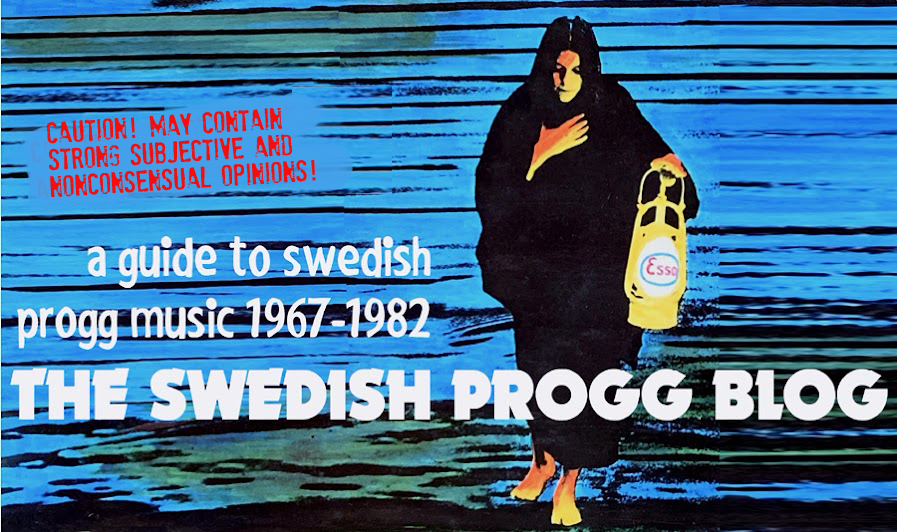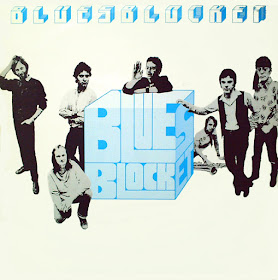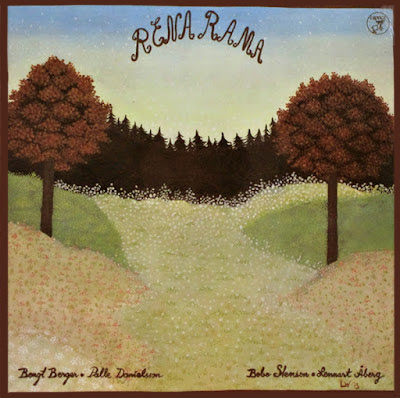The rarest ever Samla Mammas Manna
release, a cassette-only edition of 100 copies. Although it should be
said it's Samla Mammas Manna as a three-piece before they changed their name to Zamla Mammaz Manna, with Eino Haapala on
guitar, Hans Bruniusson on drums and Per Nordin on keyboards. That's
right, no Lars Hollmer.
The tape is a one-sided release (side
'B' is blank) with the 25 minute jam ”Den ovala metern” in rehearsal room audio. It's
better than the live portion of ”Schlagerns mystik/För äldre
nybegynnare”, but only just. The trio builds up a certain tension
during the first 5-6 minutes, but then it just drags on forever until
dissolving into nothing at around 15 minutes. Rare yes, but no loss.
Friday, September 21, 2018
SAMLA MAMMAS MANNA – Ur sync (Slask, MC 1988; recorded 1976)
KNÄCKEBRÖDERNA – Lyckosparken (MNW, 1976)
I can't decide whether this is supposed to be
a parody of or a tribute to Swedish rock singer/songwriter Ulf Lundell with the occasional stylistic dig at Anders F. Rönnblom or not. Not
that it matters – it doesn't get any better any which way I
look at it. I guess you could say it sounds like an uninspired
version of Blå Tåget – as it happens, Mats G. Bengtsson plays
keyboards on the album. Some bizarre touches such as 'psychedelic'
mouth harp on ”Till monarkomanin” and the sped up vocals on best
track ”Janson & von Hanzon”. Unless you consider Lennart
Holving's off-key vocals bizarre that is. I think they're just bad
like the album itself.
Precis som pärlemor
BLUESBLOCKET – Bluesblocket (Tredje Tåget, 1981)
No links found
Thursday, September 20, 2018
MONICA TÖRNELL – Jag är som jag är... (Philips, 1978) / Ingica Mångrind (Philips, 1979)
Swedish vocals
International relevance: **
After two English language albums, Monica Törnell returned to Swedish with ”Jag är som jag är...”, produced by Björn J:son Lindh and featuring Okay Temiz on percussion on ”Lotus och Casanova”. Some samba, some jazz, some fusion, some folk, some blues, all with the typical session musician sound of the day, clean and perfect and ultimately very dull.
International relevance: *
Törnell's last album of the decade is even worse than ”Jag är som jag är...” with too much production sheen and hopelessly lifeless perfomances. Worst of all is the Swedish Dylan cover of ”Like a Rolling Stone”, and the disastrous take on The Beatles' ”Drive My Car”.
ORIENTAL WIND – Bazaar (Sonet, 1981)
KEBNEKAJSE – Ljus från Afrika (Silence, 1976) / Elefanten (Silence, 1977)
Instrumental
International relevance: ***
Kebnekajse's last original album with Kenny Håkansson on guitar (and new drummer Åke Eriksson taking Pelle Ekman's place) is much closer to prog rock than what ”Ljus från Afrika” is. The African influence is kept to a minimum, but unfortunately, it has two horrible Mats Glenngård tracks pointing towards the style of ”Vi drar vidare”, ”Saab Mustang” and ”Grabbarnas afton”, totalling 18 painful minutes. Also, Håkansson must have caught the fusion virus on ”Elefantens strävan mot Nirvana”. Last track ”Halling från Ekshärad”, a traditional tune, is a throwback to Kebnekajse's folk rock years and is, after all, ”Elefanten's” high point.
Wednesday, September 19, 2018
VON ZAMLA – Zamlaranamma (Urspår, 1982)
Samla Mammas Manna's first 'Z incarnation' Zamla Mammaz Manna disbanded following the marvellous ”Familjesprickor” in 1980. The year after, Lars Hollmer and Eino Haapala formed the second 'Z incarnation', Von Zamla, and recorded this album in the autumn of 1981. Von Zamla continued up until 1984, and put out two albums before disbanding, this one and ”No Make Up!” (1983).
Like ”Familjesprickor”, the much more synthesizer heavy ”Zamlaranamma” sits firmly in the RIO category but lacks the powerful tension and brilliance. Most of this album sounds like Lars Hollmer's solo music but with a more serious approach. A lot of it sounds like a bit too intrusive background music to a TV series you're not sure if you like.The album's OK but a far cry from "Familjesprickor".
ÄLGARNAS TRÄDGÅRD – Delayed (Silence, recorded 1973-1974, released 2001)
BENGT BERGER & KJELL WESTLING – Spelar (Ett Minne För Livet, 1977)
Tuesday, September 18, 2018
SLIM'S BLUES GANG – The Blues Ain't Strange (Sonet, 1971)
Slim Notini later left the devil's music behind, became a Born Again Christian and turned to gospel music full time in the 90's.
Full album playlist
ROCKAMÖLLAN – Var ska du ta vägen? (Sonet, 1979) / Tron om varann (Marilla, 1980)
International relevance: *
VARIOUS ARTISTS – Röd 1:a maj-fest (Oktober, 1974)
International relevance: *
No links found
MWENDO DAWA – Mwendo Dawa (Dragon, 1981)
Monday, September 17, 2018
SOLAR PLEXUS – Complete albums 1972-1975
International relevance: ***
Jojje Wadenius original Swedish vocals for the album were substituted with English vocals by Tommy Körberg for an international launch. Körberg made a guest appearance on the Swedish version of the album, but after re-recording Wadenius's vocals, Körberg became a full time member of the band. Which version you prefer is a matter of taste I suppose. Both have their advantages, but my impression of the export edition is that Körberg doesn't quite feel at home being only a hired gun.
Swedish vocals, English vocals, instrumental
The album kicks off with the great, funky title track, but loses steam after that. Most of the album lacks real punch; the sound and songs are too polished, and it sounds like just another day at the jazz rock work.
International relevance: ***
Although I don't like everything they did, I have the deepest respect for them and particularly the Dominique couple. They had free souls and a huge non-discriminating love for music, which in itself is a grand source for inspiration.
ROLF WIKSTRÖM – The 70s albums
Swedish vocals, instrumental
International relevance: ***
Rolf Wikström's full length debut established his style which unfortunately also includes his vocals. While the music is OK blues in the Buddy Guy and Albert King vein, Wikström sings as if he had chewed up three pounds of chalk. His voice is so raspy it almost can't produce a sound other than a toneless screach. It's an exceedingly unpleasant experience listening to him. Would it have been better if was an instrumental album? Nope, because his guitar playing is too much as well.
International relevance: ***
MONICA TÖRNELL – Ingica (Polydor, 1972) / Alrik (Polydor, 1973)
Ingica full album playlist
Alrik full album playlist
A VARIOUS ARTISTS SPECIAL – 3 jazz compilations
Featured artists: Kustbandet / Jazz Doctors / Rolf Larsson & Jack Lidström Dixieband / Ove Linds Kvartett / Björn Milder / Umeå Big Band with Benny Bailey / Peps Blues Band / Gugge Hedrenius Big Blues Band / Lars Gullins Kvintett / Nisse Sandströms Kvartett / Lasse Werner och hans vänner / Nannie Porres Kvintett / Stefan Abeleens Kvintett / Arbe Domnérus Kvintett med Rune Gustafsson / Arbete & Fritid / Bernt Rosengrens Kvartett / Rena Rama / Egba
Featured artists: Mount Everest / Opposite Corner / Mwendo Dawa / Soffgruppen
Sunday, September 16, 2018
KEBNEKAISE – III (Silence, 1975)
MIKAEL WIEHE – Complete solo albums 1977-1982
as Mikael Wiehe och Kabaréorkestern
International relevance: *
as Kabaréorkestern
International relevance: **
as Mikael Wiehe, Nyberg, Franck & Fjellis
Mikael Wiehe has released numerous albums since.
Sjömansvisor full album playlist
Elden är lös full album playlist
Kråksånger full album playlist
De ensligas allé full album playlist
RENA RAMA – The 1970's albums

Inside-Outside (Caprice, 1979)
Instrumental
International relevance: **
In 1979 Rena Rama was back with Caprice for an album that moves between the obvious traditional influences of the first album and the more straight ahead jazz of ”Landscapes”. It's all well played but not too inspiring.
Saturday, September 15, 2018
TED STRÖM – The complete 1970's albums
KENNY HÅKANSSON – Spelar springlekar och gånglåtar (Silence, 1978)
When Kenny Håkansson's former band Kebnekajse smeared their name with shame with the ”Vi drar vidare” album, Håkansson himself made a solo album that was truer to the Kebnekajse spirit. ”Kenny Håkansson spelar springlekar och gånglåtar” – to use the full title – is split between traditional and original material, with two songs written by Arbete & Fritid affiliate Anders Rosén, ”Springlek” and the excellent album opener ”Gånglåt”; and one track written by Håkansson himself, ”Halling”. Also included is ”Trettondagsmarschen” by legendary fiddler Hjort Anders Olsson.
Shortly afterwards, Håkansson joined 'transcontinental rock reggae' band (their own term) Dag Vag, adopting stage name Beno Zeno. He also released solo ”Benos ben” under that name in 1981, an album best avoided.
An unreleased but only so-so Tonkraft recording by Kenny Håkansson Band from 1977 also exists.
SAMLA MAMMAS MANNA – Måltid (Silence, 1973) / Klossa knapitatet (Silence, 1974) / Snorungarnas symfoni (MNW, 1976)
International relevance: ***
Instrumental
International relevance: ***
Måltid full album playlist
Klossa knapitatet full album playlist
Snorungarnas symfoni full album playlist
COMBO 8 – Vibrationer (LIM, 1976)
It took Combo 8 four years and a massively trimmed down line-up (from twenty people down to six) before their sole album ”Vibrationer” was released on musicians run LIM (Levande Improviserad Musik) label in 1976. As a sextet, they still made a lot of sound. Their jazz rock/funk fusion is messy and hyperventilating, with too much going on at the same time, as if the the members wouldn't let anyone else into the spotlight. Tight yes, but overworked. Band founder and drummer Torbjörn Johansson, guitarist Björn Hallberg and bass player Ulf Mårtensson are particularly annoying.












































